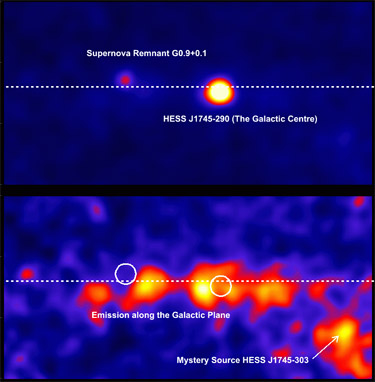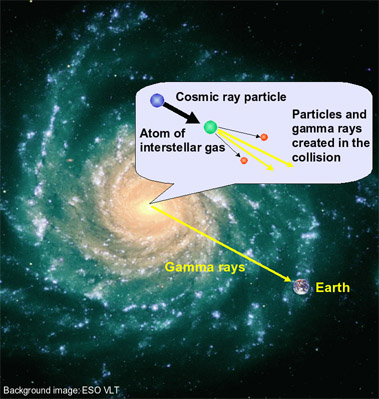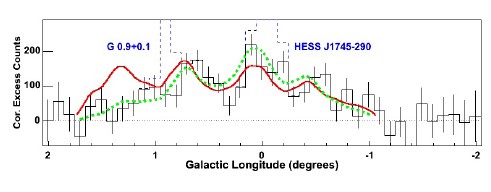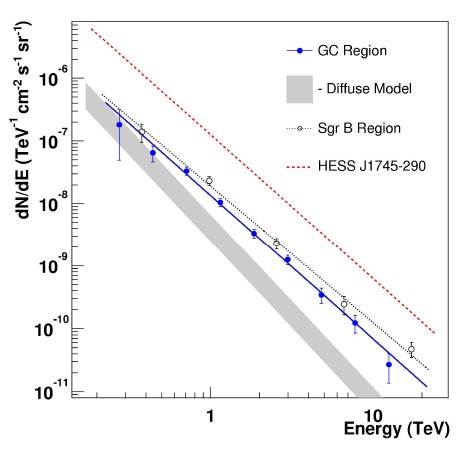High Energy Gamma Rays from the Galactic Center Ridge
March 2006

Very high energy gamma rays can be used to probe the flux of cosmic rays in distant regions of the Galaxy, shedding light on the question if the flux and spectrum of cosmic rays is uniform throughout the Galaxy, and identical to the flux measured on Earth. When cosmic rays propagate through the interstellar gas, they sometimes interact with gas particles, creating gamma rays (Fig. 1). The flux of gamma rays is proportional to the flux of "beam particles" - the cosmic rays - times the density of "target particles" - the interstellar gas. Therefore, one expects to see an enhanced gamma ray flux from the direction of dense molecular clouds, and if the cloud masses and their distances are known, one can determine to flux of cosmic rays in the gas clouds (see e.g.Aharonian 2001). Also, the energy spectrum of gamma rays resembles the energy spectrum of the cosmic rays. In the GeV energy range, this technique was used by the EGRET instrument, which revealed the band of the Galaxy glowing in gamma rays (Hunter et al., 1997), but the angular resolution of EGRET was not sufficient to resolve individual clouds.
With its good resolution and sensitivity, H.E.S.S. is in an excellent position to search for gamma rays from molecular clouds, and a first target were the very massive and dense clouds near the Galactic Center, encompassing a total gas mass of several 10 million solar masses. The clouds are mapped via their radio emission in the CO and CS lines (Oka et al. 1998,Tsuboi et al. 1999); the more common hydrogen lines are less suitable since the clouds are so dense that they are optically thick, i.e. part of the emission is absorbed in the cloud, resulting in an underestimate of the cloud mass. Indeed, once the emission from two prominent point sources in the Galactic Center region is subtracted (see Figure above), an extended band of "diffuse" gamma ray emission is visible tracing the Galactic Plane. Both in its distribution in Galactic Longitude (Fig. 2) and in Galactic Latitude, the gamma ray flux is essentially proportional to the gas density. Only at Galactic Longitude > 1 degr. on finds a deficit. A plausible explanation is that the Galactic Center clouds are illuminated by a cosmic-ray accelerator which turned on some 10000 years before the gamma rays were emitted; during these 10000 years, the cosmic rays - which meander in interstellar magnetic fields - can only propagate over some 100 pc; they have not yet reached the gas clouds at larger distance from the accelerator. This interpretation assuming a local cosmic-ray accelerator at the center of the Galaxy is supported by the measured gamma ray spectrum, which is more intense and which contains more high-energy gamma rays than expected based on the flux and spectrum of cosmic rays near Earth (Fig. 3). Near an accelerator, one naturally expects a higher intensity and harder spectrum of radiation. A candidate source might begiant supernova (Maeda et al. 2002) which might have occurred very near the Galactic Center in pre-historic time.
References:
Discovery of very-high-energy gamma rays from the Galactic Centre ridge, F. Aharonian et al., Nature 439 (2006) 695, see alsoH.E.S.S. press release


